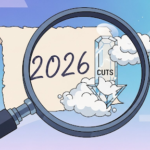When Growth Slows and Prices Climb: The Markets’ Least Favorite Combo
Markets typically don’t flinch easily—but when Goldman Sachs begins whispering “stagflation” and adjusting S&P 500 forecasts, investors take notice.
As Q1 comes to a close, the S&P 500 is facing its worst quarter since mid-2022, and the outlook has become even more negative. Goldman Sachs has lowered its short-term forecast for the index, citing a troubling combination of rising tariffs, increased inflation, and declining GDP growth. In short: higher prices, weaker demand, and a jittery market.
With the U.S. poised to impose “reciprocal” tariffs in just days, fears are growing that we’re entering a policy-induced slowdown, where growth stagnates while inflation fails to cool—a classic stagflation threat that Wall Street hoped it had left behind in the 70s.
Are we heading toward a 5% dip or a 25% drop? It’s all here—along with lessons, laughs, and a realistic look at what’s driving the market.
This Week I Learned…
Stagflation: When the Market Can’t Win Either Way
It’s rare, it’s painful, and if Goldman Sachs is correct, it might be making a comeback. The term stagflation—a toxic mix of stagnant economic growth and persistent inflation—represents one of the worst-case scenarios for both policymakers and investors. Unlike a typical slowdown, the central bank cannot simply lower rates without igniting further inflation, nor can it raise rates without exacerbating the slowdown.
The last time the U.S. truly faced stagflation was in the 1970s, when oil shocks, wage-price spirals, and aggressive policy missteps converged to hammer growth while driving inflation toward double digits. Stocks floundered. Bonds suffered. It took years—and painful interest rate hikes—to restore stability.
Why is Goldman sounding the alarm now? Tariff-induced inflation is expected to raise core PCE to 3.5% by year-end 2025, while GDP growth slows to a barely breathing 1%. That combination has already led to a downgrade in the S&P 500 EPS outlook and a call for lower valuation multiples across the board.
The lesson? Inflation-fighting doesn’t always yield clear tradeoffs. When investors can’t depend on growth or stable pricing, the risk premium for equities inevitably rises. Understanding stagflation isn’t just for macro enthusiasts anymore—it could be your portfolio’s next reality check.
The Fun Corner
Multiple Compression: Now With Extra Squeeze
Investor logic lately:
“If the economy’s slowing and inflation is rising… why are stocks still this expensive?”
Good question.
In a stagflation scenario, the math behind market valuations starts to look like a joke in itself. Earnings per share get revised down, discount rates tick up, and suddenly your ‘fair value’ model needs a fresh cup of realism.
The S&P 500’s P/E ratio has fallen from 21.5 to 20 since the beginning of the year. Goldman believes it could decline further to 19x in just a few months. That might not sound dramatic, until you remember that every one-point drop in the P/E multiple reduces the index by hundreds of points.
Fun fact: In 2002, during a previous earnings-slump-without-recession scenario, the S&P 500 P/E compressed by over 4 points in six months. The index lost nearly 20%, and earnings didn’t even collapse.
Sometimes the market doesn’t need an earnings disaster to panic. It just needs to admit it was paying too much.
Goldman Cuts Forecasts, Warns of Stagflation Stall
As April’s tariff decision approaches, Goldman Sachs has lowered its S&P 500 target for the next three months, citing an increasing risk of stagflation. While they still anticipate the index reaching 5,900 within a year, their short-term target now indicates a 5% decline, with EPS growth expectations significantly reduced.
Why the reversal? A combination of new tariff expectations—rising from 10% to 15%—and declining Q1 GDP estimates, now at just 0.2%, paints a grimmer picture for corporate earnings and investor sentiment. The result: EPS for 2025 is now forecast to be $253, down from $262, with P/E ratios decreasing.
Goldman’s economics team has also raised the recession risk to 35%, marking a significant shift from their previous 20% estimate. This change is due to declining business and consumer confidence, along with a White House seemingly prepared to endure short-term economic pain to pursue its trade agenda.
While some might take comfort in the relatively modest forecasted drop of 5%, history suggests that deeper declines are possible if a recession occurs. A typical pre-recession selloff has averaged around 25%. From the recent high of 6,144, that could imply a trough as low as 4,600.
For investors, the takeaway is straightforward yet urgent: reassess your expectations regarding earnings growth, monitor valuation compression, and brace for increased volatility. A soft landing remains possible, but the runway is quickly diminishing.
The Last Say
When Both Sides of the Equation Go Wrong
Tariffs were once political talking points—now, they’re market influencers. As Goldman revises its outlook, this week’s theme is evident: we’re entering uncharted territory where both growth and inflation metrics are trending negatively.
We’ve seen this before—decades ago—and it wasn’t pretty. A stagnating economy with rising costs creates an environment where neither equities nor fixed income provides a clear haven. While Goldman’s long-term target for the S&P 500 still suggests modest growth, the road ahead appears anything but smooth.
The investment implication? Don’t chase outdated projections. Be nimble, reassess sector exposures, and recognize that valuation multiples can—and do—compress even without massive earnings misses. When sentiment changes and risk premiums rise, entire portfolios can get repriced.
This week’s takeaway isn’t panic—it’s preparation. Understand that stagflation isn’t just an academic term—it’s now a credible scenario priced into forecasts from one of Wall Street’s most closely-watched banks.
Whether you’re managing risk or repositioning for what comes next, staying informed is no longer optional. It’s the edge that keeps you in the game.





















